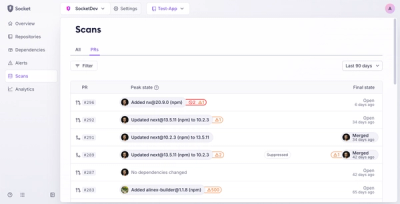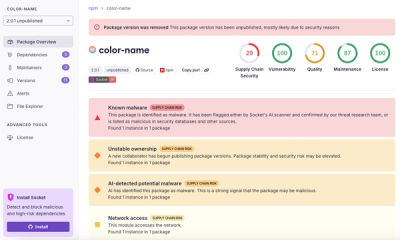
Product
Introducing Pull Request Stories to Help Security Teams Track Supply Chain Risks
Socket’s new Pull Request Stories give security teams clear visibility into dependency risks and outcomes across scanned pull requests.
Simple, zero-configuration Ethereum Name Service resolver with promises.
Works on main, ropsten, and rinkeby Ethereum networks.
npm install ez-ens
# or
yarn install ez-ens
const ens = require('ez-ens');
// Resolve 'ethereum.eth' on the mainnet.
await ens.resolve('ethereum.eth') // '0xfB6916095ca1df60bB79Ce92cE3Ea74c37c5d359'
// Resolve 'ethereum.eth' on ropsten.
await ens.resolve('ethereum.eth', {network: 'ropsten'});
// Resolve 'ethereum.eth' using the provider at http://localhost:8545.
await ens.resolve('ethereum.eth', {providerURI: 'http://localhost:8545'});
// Resolve 'ethereum.eth' using an existing web3 instance (lower overhead).
await ens.resolve('ethereum.eth', {web3: new Web3(...)});
// Resolve 'ethereum.eth' on the mainnet at a specific block number.
await ens.resolve('ethereum.eth', {block: 3013041});
// Resolve 'ethereum.eth' on the mainnet and override the TTL (cache duration).
await ens.resolve('ethereum.eth', {ttl: 3000});
// Full resolve() options.
ens.resolve(ENS_ADDRESS, {
// Manually specify how long, in ms, to keep the record in the cache.
// If not set, the TTL specified by the registrar will be used.
ttl: Number,
// Block number to evaluate the ENS record at. Defaults to latest.
block: Number,
// Network to use. Either 'main', 'ropsten', or 'rinkeby'.
// Defaults to 'main'
network: String,
// Custom provider URI. May be an http://, https://, ws://, or IPC path.
providerURI: String,
// If providerURI is an IPC path, set this to `require('net')`
net: Object,
// Custom provider instance to use (e.g., web3.currentProvider)
provider: Object,
// Custom Web3 instance to use. Lightest option if making lots of calls.
web3: Object,
// Infura project ID, if not using a custom provider.
infuraKey: String
});
ENS resolvers may implement extension EIPs, a few of which can be accessed through the following functions:
ens.getTextRecord(name, key): EIP-634 Text records.ens.getContentHash(name): EIP-1577 IPFS content hashes.ens.getBlockchainAddress(name): EIP-2304 Cross-blockchain support.ens.getCanonicalName(name): EIP-181 Reverse resolution.Once an address is resolved, the address will be cached for future calls.
Each address record has a TTL, or time-to-live, defined, which specifies how long
the cache should be retained. However, many ENS registrations unintentionally
leave the TTL at the default of 0, which would imply no caching.
So, by default, cache TTLs are clamped to be at least one hour. You can
configure this behavior yourself by setting the
ens.minTTL property to the minimum number of milliseconds to
keep a cache entry. The maximum TTL can also be specified with the ens.maxTTL
property.
const ens = require('ez-ens');
// Set the minimum TTL to 10 seconds.
ens.minTTL = 10 * 1000;
// Set the maximum TTL to 8 hours.
ens.maxTTL = 8 * 60 * 60 * 1000
FAQs
Simple, zero configuration Ethereum Name Service resolver.
We found that ez-ens demonstrated a not healthy version release cadence and project activity because the last version was released a year ago. It has 1 open source maintainer collaborating on the project.
Did you know?

Socket for GitHub automatically highlights issues in each pull request and monitors the health of all your open source dependencies. Discover the contents of your packages and block harmful activity before you install or update your dependencies.

Product
Socket’s new Pull Request Stories give security teams clear visibility into dependency risks and outcomes across scanned pull requests.

Research
/Security News
npm author Qix’s account was compromised, with malicious versions of popular packages like chalk-template, color-convert, and strip-ansi published.

Research
Four npm packages disguised as cryptographic tools steal developer credentials and send them to attacker-controlled Telegram infrastructure.